Canon M vs SL1
The Canon EOS M and the Canon EOS Rebel SL1 (labelled Canon 100D in some countries) are two digital cameras that were announced, respectively, in July 2012 and March 2013. The Canon M is a mirrorless interchangeable lens camera, while the SL1 is a DSLR. Both cameras are equipped with an APS-C sensor. Both cameras offer a resolution of 17.9 megapixels.
Below is an overview of the main specs of the two cameras as a starting point for the comparison.

Check Canon M offers at
ebay.com

Check SL1 offers at
ebay.com
Going beyond this snapshot of core features and characteristics, what are the differences between the Canon EOS M and the Canon EOS Rebel SL1? Which one should you buy? Read on to find out how these two cameras compare with respect to their body size, their imaging sensors, their shooting features, their input-output connections, and their reception by expert reviewers.
Body comparison
The side-by-side display below illustrates the physical size and weight of the Canon M and the Canon SL1. The two cameras are presented according to their relative size. Three consecutive perspectives from the front, the top, and the back are available. All width, height and depth dimensions are rounded to the nearest millimeter.
Both cameras are available in two different colors (black, white).
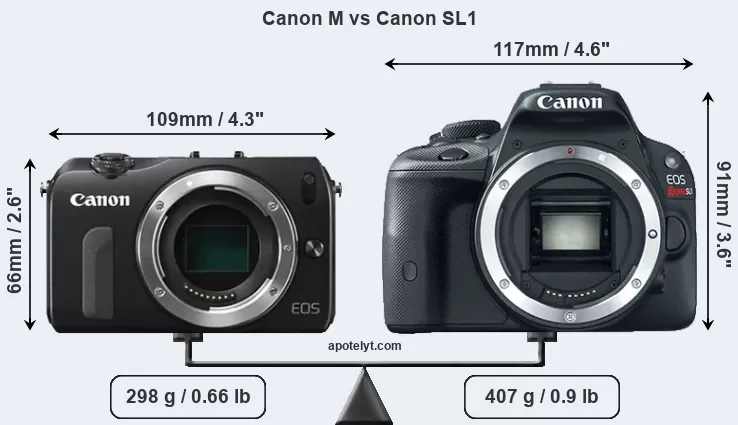
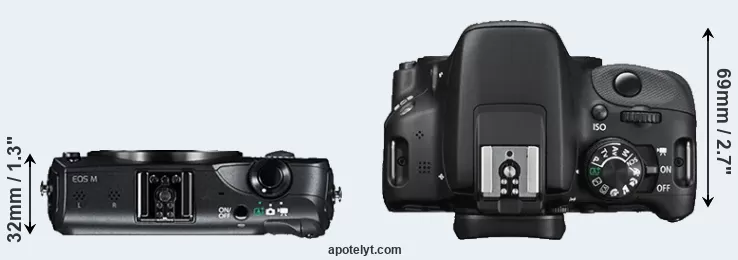
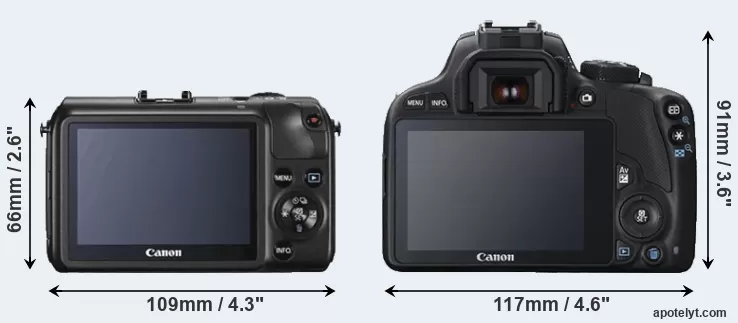
If the front view area (width x height) of the cameras is taken as an aggregate measure of their size, the Canon SL1 is considerably larger (48 percent) than the Canon M. Moreover, the SL1 is substantially heavier (37 percent) than the Canon M. In this context, it is worth noting that neither the Canon M nor the SL1 are weather-sealed.
The above size and weight comparisons are to some extent incomplete since they do not consider the interchangeable lenses that both of these cameras require. Hence, you might want to study and compare the specifications of available lenses in order to get the full picture of the size and weight of the two camera systems.
The adjacent table lists the principal physical characteristics of the two cameras alongside a wider set of alternatives. In case you want to display and compare another camera duo, you can use the CAM-parator app to select your camera combination among a large number of options.

| Camera Model |
Camera Width |
Camera Height |
Camera Depth |
Camera Weight |
Battery Life |
Weather Sealing |
Camera Launch |
Launch Price |
Street Price |
||
|---|---|---|---|---|---|---|---|---|---|---|---|
| 1. | Canon M | 109 mm | 66 mm | 32 mm | 298 g | 230 | n | Jul 2012 | US$ 599 | ebay.com | |
| 2. | Canon SL1 | 117 mm | 91 mm | 69 mm | 407 g | 380 | n | Mar 2013 | US$ 549 | ebay.com | |
| 3. | Canon G7 X | 103 mm | 60 mm | 40 mm | 304 g | 210 | n | Sep 2014 | US$ 699 | ebay.com | |
| 4. | Canon G16 | 109 mm | 76 mm | 40 mm | 356 g | 360 | n | Aug 2013 | US$ 549 | ebay.com | |
| 5. | Canon M10 | 108 mm | 67 mm | 35 mm | 301 g | 255 | n | Oct 2015 | US$ 499 | ebay.com | |
| 6. | Canon M100 | 108 mm | 67 mm | 35 mm | 302 g | 295 | n | Aug 2017 | US$ 499 | ebay.com | |
| 7. | Canon SL2 | 122 mm | 93 mm | 70 mm | 453 g | 650 | n | Jun 2017 | US$ 549 | ebay.com | |
| 8. | Canon T3i | 133 mm | 100 mm | 80 mm | 570 g | 440 | n | Feb 2011 | US$ 599 | ebay.com | |
| 9. | Canon T4i | 133 mm | 100 mm | 79 mm | 575 g | 440 | n | Jun 2012 | US$ 849 | ebay.com | |
| 10. | Canon T5i | 133 mm | 100 mm | 79 mm | 580 g | 440 | n | Mar 2013 | US$ 649 | ebay.com | |
| 11. | Panasonic G3 | 115 mm | 84 mm | 47 mm | 336 g | 270 | n | May 2011 | US$ 599 | ebay.com | |
| 12. | Panasonic GF6 | 111 mm | 65 mm | 38 mm | 323 g | 340 | n | Apr 2013 | US$ 499 | ebay.com | |
| 13. | Sony NEX-3N | 110 mm | 62 mm | 35 mm | 269 g | 480 | n | Feb 2013 | US$ 499 | ebay.com | |
| Note: Measurements and pricing do not include easily detachable parts, such as add-on or interchangeable lenses or optional viewfinders. | |||||||||||
Any camera decision will naturally be influenced heavily by the price. The listed launch prices provide an indication of the market segment that the manufacturer of the cameras have been targeting. The SL1 was somewhat cheaper (by 8 percent) than the Canon M at launch, but both cameras fall into the same price category. Usually, retail prices stay at first close to the launch price, but after several months, discounts become available. Later in the product cycle and, in particular, when the replacement model is about to appear, further discounting and stock clearance sales often push the camera price considerably down. Then, after the new model is out, very good deals can frequently be found on the pre-owned market.
Sensor comparison
The size of the sensor inside a digital camera is one of the key determinants of image quality. A large sensor will tend to have larger individual pixels that provide better low-light sensitivity, wider dynamic range, and richer color-depth than smaller pixel-units in a sensor of the same technological generation. Further, a large sensor camera will give the photographer additional creative options when using shallow depth-of-field to isolate a subject from its background. On the downside, larger sensors tend to be associated with larger, more expensive camera bodies and lenses.
Both cameras under consideration feature an APS-C sensor and have a format factor (sometimes also referred to as "crop factor") of 1.6. Within the spectrum of camera sensors, this places the review cameras among the medium-sized sensor cameras that aim to strike a balance between image quality and portability. Both cameras have a native aspect ratio (sensor width to sensor height) of 3:2.
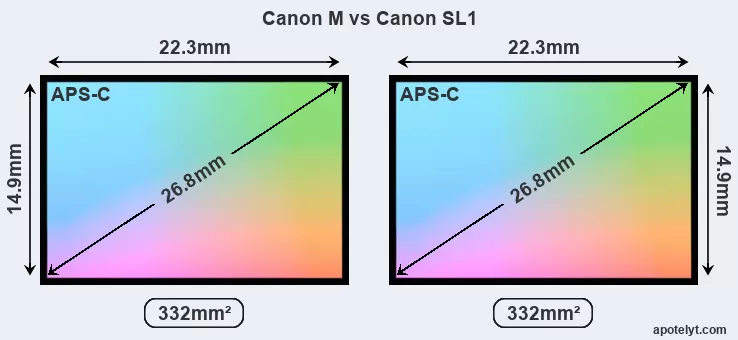
The two cameras under review do not only share the same sensor size, but also offer an identical resolution of 17.9 megapixels. This similarity in sensor specs implies that both the Canon M and the SL1 have the same pixel density, as well as the same pixel size. It should, however, be noted that the SL1 is a somewhat more recent model (by 7 months) than the Canon M, and its sensor might have benefitted from technological advances during this time.
The Canon EOS M has a native sensitivity range from ISO 100 to ISO 12800, which can be extended to ISO 100-25600. The Canon EOS Rebel SL1 offers exactly the same ISO settings.
Technology-wise, both cameras are equipped with CMOS (Complementary Metal–Oxide–Semiconductor) sensors. Both cameras use a Bayer filter for capturing RGB colors on a square grid of photosensors. This arrangement is found in most digital cameras.
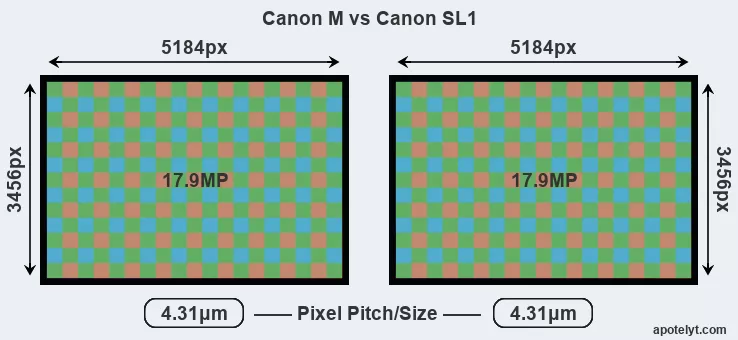
Since 2007, DXO Mark has published sensor performance measurements that have been derived using a consistent methodology. This service is based on lab testing and assigns an overall score to each camera sensor, as well as ratings for dynamic range ("DXO Landscape"), color depth ("DXO Portrait"), and low-light sensitivity ("DXO Sports"). The Overall DXO ratings for the two cameras under consideration are close, suggesting that they provide similar imaging performance. The adjacent table reports on the physical sensor characteristics and the outcomes of the DXO sensor quality tests for a sample of comparator-cameras.

| Camera Model |
Sensor Class |
Resolution (MP) |
Horiz. Pixels |
Vert. Pixels |
Video Format |
DXO Portrait |
DXO Landscape |
DXO Sports |
DXO Overall |
||
|---|---|---|---|---|---|---|---|---|---|---|---|
| 1. | Canon M | APS-C | 17.9 | 5184 | 3456 | 1080/30p | 22.1 | 11.2 | 827 | 65 | |
| 2. | Canon SL1 | APS-C | 17.9 | 5184 | 3456 | 1080/30p | 21.8 | 11.3 | 843 | 63 | |
| 3. | Canon G7 X | 1-inch | 20.0 | 5472 | 3648 | 1080/60p | 23.0 | 12.7 | 556 | 71 | |
| 4. | Canon G16 | 1/1.7 | 12.0 | 4000 | 3000 | 1080/60p | 21.0 | 11.7 | 230 | 54 | |
| 5. | Canon M10 | APS-C | 17.9 | 5184 | 3456 | 1080/30p | 22.2 | 11.4 | 753 | 65 | |
| 6. | Canon M100 | APS-C | 24.0 | 6000 | 4000 | 1080/60p | 23.5 | 12.9 | 1272 | 78 | |
| 7. | Canon SL2 | APS-C | 24.0 | 6000 | 4000 | 1080/60p | 23.6 | 13.4 | 1041 | 79 | |
| 8. | Canon T3i | APS-C | 17.9 | 5184 | 3456 | 1080/30p | 22.1 | 11.5 | 793 | 65 | |
| 9. | Canon T4i | APS-C | 17.9 | 5184 | 3456 | 1080/30p | 21.7 | 11.2 | 722 | 62 | |
| 10. | Canon T5i | APS-C | 17.9 | 5184 | 3456 | 1080/30p | 21.7 | 11.2 | 681 | 61 | |
| 11. | Panasonic G3 | Four Thirds | 15.8 | 4592 | 3448 | 1080/60i | 21.0 | 10.6 | 667 | 56 | |
| 12. | Panasonic GF6 | Four Thirds | 15.8 | 4592 | 3448 | 1080/60i | 20.7 | 10.6 | 622 | 54 | |
| 13. | Sony NEX-3N | APS-C | 16.0 | 4912 | 3264 | 1080/60i | 22.8 | 12.5 | 1067 | 74 |
Many modern cameras are not only capable of taking still images, but also of capturing video footage. Both cameras under consideration have a sensor with sufficiently fast read-out times for moving pictures, and both provide the same movie specifications (1080/30p).
Feature comparison
Apart from body and sensor, cameras can and do differ across a variety of features. For example, the SL1 has an optical viewfinder, which can be very useful when shooting in bright sunlight. In contrast, the Canon M relies on live view and the rear LCD for framing. The adjacent table lists some of the other core features of the Canon M and Canon SL1 along with similar information for a selection of comparators.

| Camera Model |
Viewfinder (Type or 000 dots) |
Control Panel (yes/no) |
LCD Specifications (inch/000 dots) |
LCD Attach- ment |
Touch Screen (yes/no) |
Max Shutter Speed * |
Max Shutter Flaps * |
Built-in Flash (yes/no) |
Built-in Image Stab |
||
|---|---|---|---|---|---|---|---|---|---|---|---|
| 1. | Canon M | none | n | 3.0 / 1040 | fixed | Y | 1/4000s | 4.3/s | n | n | |
| 2. | Canon SL1 | optical | n | 3.0 / 1040 | fixed | Y | 1/4000s | 4.9/s | Y | n | |
| 3. | Canon G7 X | none | n | 3.0 / 1040 | tilting | Y | 1/2000s | 6.5/s | Y | Y | |
| 4. | Canon G16 | optical | n | 3.0 / 922 | fixed | n | 1/4000s | 2.2/s | Y | Y | |
| 5. | Canon M10 | none | n | 3.0 / 1040 | tilting | Y | 1/4000s | 4.6/s | Y | n | |
| 6. | Canon M100 | none | n | 3.0 / 1040 | tilting | Y | 1/4000s | 6.1/s | Y | n | |
| 7. | Canon SL2 | optical | n | 3.0 / 1040 | swivel | Y | 1/4000s | 5.0/s | Y | n | |
| 8. | Canon T3i | optical | n | 3.0 / 1040 | swivel | n | 1/4000s | 3.7/s | Y | n | |
| 9. | Canon T4i | optical | n | 3.0 / 1040 | swivel | Y | 1/4000s | 5.0/s | Y | n | |
| 10. | Canon T5i | optical | n | 3.0 / 1040 | swivel | Y | 1/4000s | 5.0/s | Y | n | |
| 11. | Panasonic G3 | 1440 | n | 3.0 / 460 | swivel | Y | 1/4000s | 4.0/s | Y | n | |
| 12. | Panasonic GF6 | none | n | 3.0 / 1040 | tilting | Y | 1/4000s | 4.2/s | Y | n | |
| 13. | Sony NEX-3N | optional | n | 3.0 / 460 | tilting | n | 1/4000s | 4.0/s | Y | n | |
| Note: *) Information refers to the mechanical shutter, unless the camera only has an electronic one. | |||||||||||
One difference between the cameras concerns the presence of an on-board flash. The SL1 has one, while the Canon M does not. While the built-in flash of the SL1 is not very powerful, it can at times be useful as a fill-in light.
Concerning the storage of imaging data, both the Canon M and the SL1 write their files to SDXC cards. Both cameras can use UHS-I cards, which provide for Ultra High Speed data transfer of up to 104 MB/s.
Connectivity comparison
For some imaging applications, the extent to which a camera can communicate with its environment can be an important aspect in the camera decision process. The table below provides an overview of the connectivity of the Canon EOS M and Canon EOS Rebel SL1 and, in particular, the interfaces the cameras (and selected comparators) provide for accessory control and data transfer.

| Camera Model |
Hotshoe Port |
Internal Mic / Speaker |
Microphone Port |
Headphone Port |
HDMI Port |
USB Port |
WiFi Support |
NFC Support |
Bluetooth Support |
||
|---|---|---|---|---|---|---|---|---|---|---|---|
| 1. | Canon M | Y | stereo / mono | Y | - | mini | 2.0 | - | - | - | |
| 2. | Canon SL1 | Y | mono / mono | Y | - | mini | 2.0 | - | - | - | |
| 3. | Canon G7 X | - | stereo / mono | - | - | micro | 2.0 | Y | Y | - | |
| 4. | Canon G16 | Y | stereo / mono | - | - | mini | 2.0 | Y | - | - | |
| 5. | Canon M10 | - | stereo / mono | - | - | mini | 2.0 | Y | Y | - | |
| 6. | Canon M100 | - | stereo / mono | - | - | micro | 2.0 | Y | Y | Y | |
| 7. | Canon SL2 | Y | stereo / mono | Y | - | mini | 2.0 | Y | Y | Y | |
| 8. | Canon T3i | Y | mono / mono | Y | - | mini | 2.0 | - | - | - | |
| 9. | Canon T4i | Y | stereo / mono | Y | - | mini | 2.0 | - | - | - | |
| 10. | Canon T5i | Y | stereo / mono | Y | - | mini | 2.0 | - | - | - | |
| 11. | Panasonic G3 | Y | stereo / mono | - | - | mini | 2.0 | - | - | - | |
| 12. | Panasonic GF6 | - | stereo / mono | - | - | mini | 2.0 | Y | Y | - | |
| 13. | Sony NEX-3N | - | stereo / mono | - | - | micro | 2.0 | - | - | - |
Both the Canon M and the SL1 have been discontinued, but can regularly be found used on ebay. The Canon M was replaced by the Canon EOS M3, while the SL1 was followed by the Canon SL2. Further information on the features and operation of the Canon M and SL1 can be found, respectively, in the Canon M Manual (free pdf) or the online Canon SL1 Manual.
Review summary
So how do things add up? Is there a clear favorite between the Canon M and the Canon SL1? Which camera is better? Below is a summary of the relative strengths of each of the two contestants.
Advantages of the Canon EOS M:
- More compact: Is smaller (109x66mm vs 117x91mm) and thus needs less room in the bag.
- Less heavy: Is lighter (by 109g or 27 percent) and hence easier to carry around.
- More legacy lens friendly: Can take a broad range of non-native lenses via adapters.
- More heavily discounted: Has been on the market for longer (launched in July 2012).
Arguments in favor of the Canon EOS Rebel SL1:
- Easier framing: Has an optical viewfinder for image composition and settings control.
- Faster burst: Shoots at higher frequency (4.9 vs 4.3 flaps/sec) to capture the decisive moment.
- Longer lasting: Gets more shots (380 versus 230) out of a single battery charge.
- Easier fill-in: Has a small integrated flash to brighten shadows of backlit subjects.
- More modern: Was introduced somewhat (7 months) more recently.
If the number of relative strengths (bullet points above) is taken as a guide, the SL1 comes out slightly ahead of the Canon M (5 : 4 points). However, the relevance of individual strengths will vary across photographers, so that you might want to apply your own weighing scheme to the summary points when reflecting and deciding on a new camera. A professional wildlife photographer will view the differences between cameras in a way that diverges from the perspective of a family photog, and a person interested in architecture has distinct needs from a sports shooter. Hence, the decision which camera is best and worth buying is often a very personal one.
How about other alternatives? Do the specifications of the Canon M and the Canon SL1 place the cameras among the top in their class? Find out in the latest Best Mirrorless Interchangeable Lens Camera and Best DSLR Camera listings whether the two cameras rank among the cream of the crop.
In any case, while the comparison of the spec-sheets of cameras can offer a general idea of their imaging potential, it says little about, for example, the shooting experience and imaging performance of the Canon M and the SL1 in practical situations. At times, user reviews, such as those published at amazon, address these issues in a useful manner, but such feedback is on many occasions incomplete, inconsistent, and unreliable.
Expert reviews
This is why hands-on reviews by experts are important. The adjacent summary-table relays the overall verdicts of several of the most popular camera review sites (amateurphotographer [AP], cameralabs [CL], digitalcameraworld [DCW], dpreview [DPR], ephotozine [EPZ], photographyblog [PB]). As can be seen, the professional reviewers agree in many cases on the quality of different cameras, but sometimes their assessments diverge, reinforcing the earlier point that a camera decision is often a very personal choice.

| Camera Model |
AP score |
CL score |
DCW score |
DPR score |
EPZ score |
PB score |
Camera Launch |
Launch Price |
Street Price |
||
|---|---|---|---|---|---|---|---|---|---|---|---|
| 1. | Canon M | 3/5 | + | .. | .. | 4/5 | 4/5 | Jul 2012 | US$ 599 | ebay.com | |
| 2. | Canon SL1 | 4/5 | + | .. | 78/100 | 4/5 | 4/5 | Mar 2013 | US$ 549 | ebay.com | |
| 3. | Canon G7 X | 4/5 | + + | .. | 77/100 | 4.5/5 | 4.5/5 | Sep 2014 | US$ 699 | ebay.com | |
| 4. | Canon G16 | 4/5 | + | .. | .. | 4.5/5 | 4.5/5 | Aug 2013 | US$ 549 | ebay.com | |
| 5. | Canon M10 | .. | .. | .. | .. | .. | 4/5 | Oct 2015 | US$ 499 | ebay.com | |
| 6. | Canon M100 | 3/5 | + | .. | .. | 4/5 | 3.5/5 | Aug 2017 | US$ 499 | ebay.com | |
| 7. | Canon SL2 | 4/5 | + + | 4/5 | 78/100 | 4.5/5 | 4.5/5 | Jun 2017 | US$ 549 | ebay.com | |
| 8. | Canon T3i | 3/5 | o | .. | 77/100 | 4.5/5 | 4.5/5 | Feb 2011 | US$ 599 | ebay.com | |
| 9. | Canon T4i | 4/5 | + + | .. | 77/100 | 4.5/5 | 4.5/5 | Jun 2012 | US$ 849 | ebay.com | |
| 10. | Canon T5i | .. | .. | .. | 76/100 | 4.5/5 | 4.5/5 | Mar 2013 | US$ 649 | ebay.com | |
| 11. | Panasonic G3 | 3/5 | + + | .. | 75/100 | 4.5/5 | 5/5 | May 2011 | US$ 599 | ebay.com | |
| 12. | Panasonic GF6 | .. | + + | .. | .. | 4.5/5 | 4.5/5 | Apr 2013 | US$ 499 | ebay.com | |
| 13. | Sony NEX-3N | 3/5 | .. | .. | .. | 4.5/5 | 4.5/5 | Feb 2013 | US$ 499 | ebay.com | |
| Note: (+ +) highly recommended; (+) recommended; (o) reviewed; (..) not available. | |||||||||||
The above review scores should be interpreted with care, though. The ratings were established in reference to similarly priced cameras that were available in the market at the time of the review. Thus, a score needs to be put into the context of the launch date and the launch price of the camera, and comparing ratings of very distinct cameras or ones that are far apart in terms of their release date have little meaning. Also, kindly note that some of the listed sites have over time developped their review approaches and their reporting style.

Check Canon M offers at
ebay.com

Check SL1 offers at
ebay.com
Other camera comparisons
Did this review help to inform your camera decision process? In case you are interested in seeing how other cameras pair up, just make a corresponding selection in the search boxes below. Alternatively, you can follow any of the listed hyperlinks for comparisons that others found interesting.
Specifications: Canon M vs Canon SL1
Below is a side-by-side comparison of the specs of the two cameras to facilitate a quick review of their differences and common features.
| Camera Model | Canon M | Canon SL1 |
|---|---|---|
| Camera Type | Mirrorless system camera | Digital single lens reflex |
| Camera Lens | Canon EF-M mount lenses | Canon EF mount lenses |
| Launch Date | July 2012 | March 2013 |
| Launch Price | USD 599 | USD 549 |
| Sensor Specs | Canon M | Canon SL1 |
| Sensor Technology | CMOS | CMOS |
| Sensor Format | APS-C Sensor | APS-C Sensor |
| Sensor Size | 22.3 x 14.9 mm | 22.3 x 14.9 mm |
| Sensor Area | 332.27 mm2 | 332.27 mm2 |
| Sensor Diagonal | 26.8 mm | 26.8 mm |
| Crop Factor | 1.6x | 1.6x |
| Sensor Resolution | 17.9 Megapixels | 17.9 Megapixels |
| Image Resolution | 5184 x 3456 pixels | 5184 x 3456 pixels |
| Pixel Pitch | 4.31 μm | 4.31 μm |
| Pixel Density | 5.39 MP/cm2 | 5.39 MP/cm2 |
| Moiré control | Anti-Alias filter | Anti-Alias filter |
| Movie Capability | 1080/30p Video | 1080/30p Video |
| ISO Setting | 100 - 12,800 ISO | 100 - 12,800 ISO |
| ISO Boost | 100 - 25,600 ISO | 100 - 25,600 ISO |
| Image Processor | DIGIC V | DIGIC 5 |
| DXO Sensor Quality (score) | 65 | 63 |
| DXO Color Depth (bits) | 22.1 | 21.8 |
| DXO Dynamic Range (EV) | 11.2 | 11.3 |
| DXO Low Light (ISO) | 827 | 843 |
| Screen Specs | Canon M | Canon SL1 |
| Viewfinder Type | no viewfinder | Optical viewfinder |
| Viewfinder Field of View | 95% | |
| Viewfinder Magnification | 0.54x | |
| LCD Framing | Live View | Live View |
| Rear LCD Size | 3.0inch | 3.0inch |
| LCD Resolution | 1040k dots | 1040k dots |
| LCD Attachment | Fixed screen | Fixed screen |
| Touch Input | Touchscreen | Touchscreen |
| Shooting Specs | Canon M | Canon SL1 |
| Focus System | On-Sensor Phase-detect | Phase-detect AF |
| Continuous Shooting | 4.3 shutter flaps/s | 4.9 shutter flaps/s |
| Shutter Life Expectancy | 100 000 actuations | 100 000 actuations |
| Fill Flash | no On-Board Flash | Built-in Flash |
| Storage Medium | SDXC cards | SDXC cards |
| Single or Dual Card Slots | Single card slot | Single card slot |
| UHS card support | UHS-I | UHS-I |
| Connectivity Specs | Canon M | Canon SL1 |
| External Flash | Hotshoe | Hotshoe |
| USB Connector | USB 2.0 | USB 2.0 |
| HDMI Port | mini HDMI | mini HDMI |
| Microphone Port | External MIC port | External MIC port |
| Wifi Support | no Wifi | no Wifi |
| Body Specs | Canon M | Canon SL1 |
| Battery Type | Canon LP-E12 | Canon LP-E12 |
| Battery Life (CIPA) | 230 shots per charge | 380 shots per charge |
| Body Dimensions |
109 x 66 x 32 mm (4.3 x 2.6 x 1.3 in) |
117 x 91 x 69 mm (4.6 x 3.6 x 2.7 in) |
| Camera Weight | 298 g (10.5 oz) | 407 g (14.4 oz) |

Check Canon M offers at
ebay.com

Check SL1 offers at
ebay.com
Did you notice an error on this page? If so, please get in touch, so that we can correct the information.

